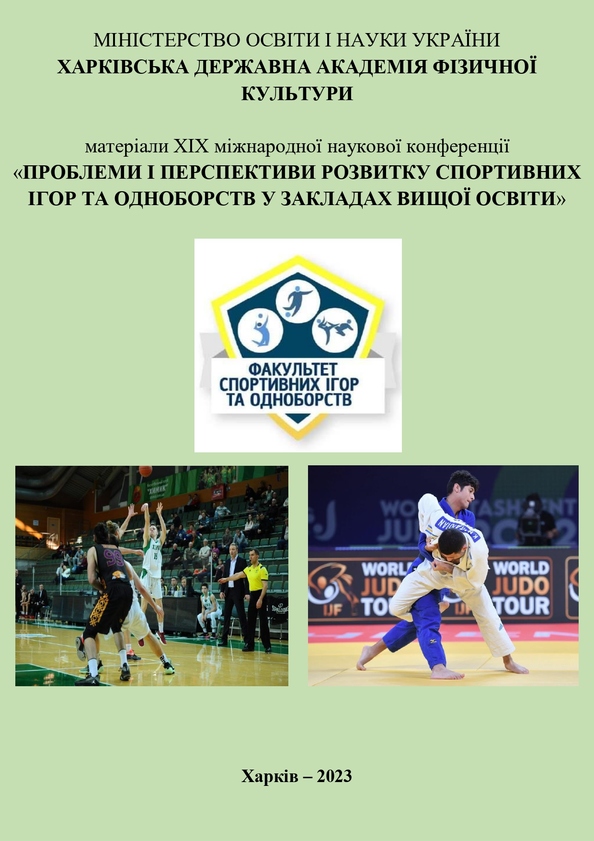Davlat Bobonov’s individual technical-tactical profile
Ключові слова:
judo, efficiency of techniques, individual profileАнотація
Abstract. This study aims to analysis technical-tactical profile Davlat Bobonov, Tokyo Olympic bronze medal winner. The observations were conducted using the special video analysis in the 125 official judo contests organized by the IJF. During the analysis, there were determined ratios of standing and ground work techniques, efficiency of standing fight and grappling techniques. The results showed that 24,8 % of effective techniques obtained by Bobonov in katame waza, while 75,2 % techniques ne waza. He very effectively performed koshi waza, sutemu waza, ashi and te waza techniques. The results which have been presented in this study are of individual character of one competitor’s technical-tactical profile. Such kind of analysis and observations may determine individual profile of male judo training, and guide to judo coaches in their preparation process. The results may also be used as desired model of technical-tactical preparation of qualified judokas. Determining relations and analogues, similarities between the profiles contests of the other competitors, allows to formulate new strategy for future training.
Посилання
Adam, M, Klimowicz, P, & Pujszo, R. (2016). Judoists’ tactical and technical efficiency during the World Championships in 2014 and 2015. Baltic Journal of Health and Physical Activity, 8. 19-28. 10.29359/BJHPA.08.2.02.
Bompa, T., & Buzzichelle, C. (2019). Periodization of Strength Training for Sports. 4th Edition. Human Kinetics Press.
Brousse, M, & Matsumoto, D. (1999). Judo And Sport A Way Of Life. The inclusion of women’s judo. International Judo Federation. San Francisco, California.
Błach, W, Rydzik, Ł, Błac, Ł., Cynarski, W. J., Kostrzew, M, & Ambroży, T. (2021). Characteristics of Technical and Tactical Preparation of Elite Judokas during the World Championships and Olympic Games. International journal of environmental research and public health, 18(11), 5841. https://doi.org/10.3390/ijerph18115841
Callan, M. (2018). Scientific Research in Judo: a potted history.
Giovani, M, Franchini, E, Jose, R.J, & Tudiro, L.B. (2010). Structural Analysis of Action and Time in Sport: Judo. Journal of Quantitative Analysis in Sport, 32, 12-18. DOI: 10.2202/1559-0410.1226.
Ruiken, R. (1991). Wettkampfanalyse Beobachtung der Judo-WM der Frauen 1986. [in German]. Judo-Magazin, 2, 14-15.
Nakamura, I., Yamaguchi, K., Shigeoka, T., Hamada, H., & Takeuchi, Y. (2005). Comparison of Performance between Male and Female in 2003 World Judo championships. Bulletin of the Association for the Scientific Studies on judo. Kodokan Report, 77-85.
Miarka, B., Cury, R., Julianetti, R., Battazza, R., Julio, U.F., Calmet, M., & Franchini, E. (2014). A comparison of time-motion and technical-tactical variables between age groups of female judo matches. Journal of Sports Sciences, 32, 1529-1538.
Miarka, B., Panissa, V.L., Julio, U.F., Del Vecchio, F.B., Calmet, M., & Franchini, E. (2012). A comparison of time-motion performance between age groups in judo matches. Journal of Sports Sciences, 30, 899-905.
Sacripanti, A., & Ahmedov, F. (2021). JUDO. Manual.
Shavkatovich, F.A. (2020). The relationship between the weight classes and competitive activity of judo athletes. Int. J. Phys. Educ. Sport. Health, 7, 108-111.
Sterkowicz, S., & Kęsek, M. (1983). Charakterystyka działań podczas I Międzynarodowego Turnieju judo kobiet. [in Polish].
International Judo Federation Refereeing Rules. - [Electronic resource]. - Access mode: https://www.ijf.org. (date of access 11.10.22).
International Judo Federation countrry. - [Electronic resource]. - Access mode: https://www.ijf.org/country/uzb. International Judo Federation. (date of access 10.10.22).
International Judo Federation category. - [Electronic resource]. - Access mode: https://www.ijf.org/wrl?category=5&view=expanded. International Judo Federation. (date of access 10.10.22).

